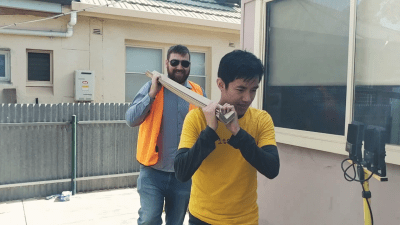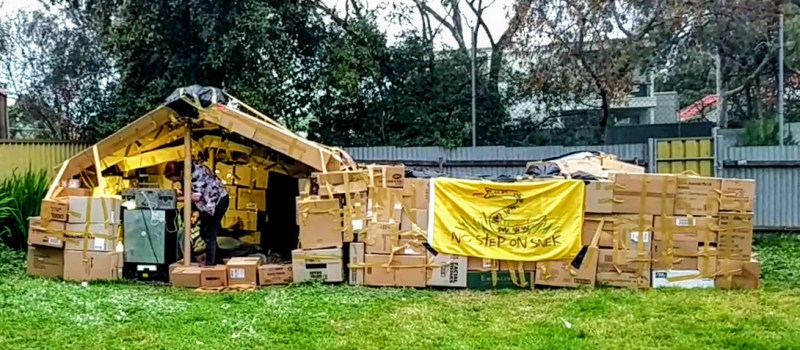Many a grown up can reminisce about building various architectural wonders in their youth. Forts, whether based on boxes or blankets, were the order of the day, and an excellent way to spend a rainy Sunday afternoon.
It just so happens that there is no law against scaling up such activities once one has reached the age of majority. However, to build a structure at this level takes some careful planning and consideration, and that is the purpose of our article here today.
Location, Location, Location

The first major consideration when starting your build should be the area in which you wish to do it. Building inside has the advantage of avoiding the weather, however hard floors can lead to sore knees when crawling around. Additionally, you’re a grown up now, so it’s less likely your peers will be impressed to hear you sat inside a box in your living room.
No, if you’re going to do this right, you’ll want to go outside. A nice flat lawn is best, providing soft ground and plenty of space. The challenges of the elements will guide your work – sitting inside your cardboard home feels all the more satisfying when you’re cosy and dry as you listen to the patter of rain on the roof. There’s a real sense of accomplishment when you’ve built something that can survive the harsh outdoors, and besides, the views are better, too.
Materials
Obviously, to build a box fort, you need boxes, and now you’re no longer three feet tall, you’re gonna need a lot of them. If you’ve struck it rich on the Bitcoin markets, you’re in luck – place an order with your local packaging company for as many as you need and you’re all set. However, for the rest of us, there’s plenty of ways to scrounge up materials.
The simple fact is, the retail industry goes through tons of packaging – literally. The trick is knowing where to look. As far as Australia goes, the big supermarkets are largely a waste of time because boxes are crushed almost immediately and recycled once used. Smaller supermarkets, however, particularly those with a more community focus, are often more than happy to put aside some leftovers from the night fill run. They’re a great source of your small-to-medium regular boxes.
Ideally though, you want the biggest boxes you can get. This is where hardware and furniture stores come in. Volumes are low, so they’re generally flattened and disposed of manually, meaning they’re often available if you’re willing to show up and take them away.

Flattened cardboard boxes aren’t the be-all and end-all, however. When you’re building an advanced structure, you need beams that can bear some decent loads. This is where you need to be hunting for cardboard L-angles, or even cardboard carpet tubes. These sections are very high strength and are invaluable when it comes time to put up your roof.
The real trick here is actually communication. You need to be able to identify who has what you want, and then contact them and see if you can pick up their waste cardboard. It’s often as simple as picking up the phone and explaining politely that you’re doing a project and would love to pick up any spare boxes they’re getting rid of. Generally people are more than willing to help, and if not – no problem! There’s always somewhere else to try.
Outside of cardboard, you’ll need one more thing – a hell of a lot of tape. However much you think you’ll need, quadruple it. Trust me.
Building Techniques

So you’ve stepped outside, it’s a beautiful day, and your friends will be here any minute. How do you turn this hulking pile of cardboard into a building you can be proud of?
The first step is to plan. Get a rough idea in your head of what you want to do – how many rooms, secret tunnels, and so on. Then begin laying out your boxes to build the perimeter walls. Get inside and move about, and see if you’ve got the dimensions right. It’s important to get this correct at the beginning, so you don’t end up with a cramped, uncomfortable hang-out space that your friends don’t want to play in.
Typically, if you’re working with a variety of boxes in different shapes and sizes, the best way to build is by using the boxes in their folded-up box state, rather than as flat cardboard. Working with flat cardboard can give a very clean look, but such a design requires a lot of beams, such as L-angles or others, to hold the walls up. Given that such materials are harder to come by, building with box units is typically much more accessible and gives that classic box-fort look.

It’s important to stagger your boxes – the boxes in the higher layer in a wall overlap the ones below. This helps lock the wall together, giving it a more resilient structure. If you’re going for a quick and dirty build, this technique, combined with lashings of tape, is usually enough. However, if you want to get fancy, or you’re building in a high-wind area, you may want to consider some more advanced brickwork techniques. Another useful idea is to weigh down the boxes at the base of your walls. This acts as a strong foundation and makes your boxes less likely to skate around as your fort’s inhabitants bounce around.
Flooring is an area where your imagination really is the limit. If you’ve got a great lawn, you may not need flooring at all! Alternatively, tarpaulins or various types of linoleum sheet can be used for a hard-wearing surface. However, having undertaken this project, it’s likely you’ll find yourself with an abundant supply of, yes – cardboard. Flattened boxes make an excellent cheap flooring solution, and you’ve likely already got all the materials you need to hand.
The roof is often where things begin to get complicated. Yes, an open air fort can be fun, but it lacks a certain coziness and privacy that you can’t get without a ceiling. If you’ve built your fort to proper adult dimensions, you’ll find you’ve got quite a distance to span across your walls if you’re going to close things in from up top.
This is where the engineering comes in. If you try to simply place flat sheets across a wide gap, they’ll sag in the middle. They need support. The thing to consider here is the deflection of your roof structure. For a simple rectangular beam, the formula below is used to calculate the second moment of area.

The second moment of area is very important in this regard; a higher second moment of area means your beam will resist deflection better. A lower second moment of area means that your beam will not hold up well at all. Note the terms in the equation – b for base width, h for height. The height term is cubed, meaning that the height of the beam has a far greater role to play where rigidity is concerned.
This is why I-beams and C-beams are so commonly used in construction – they have excellent rigidity in the vertical plane and thus can spread loads well. Obviously the calculations get more complex, but the key is always that the height makes more difference when talking about rigidity against vertical deflection.
To visualise this in a simple manner, take a steel ruler and hang it over the edge of a desk. Laying flat, it takes very little force to deflect the ruler. However, stand the ruler on its edge, and it is incredibly rigid and requires enormous force to deflect!
What does this mean for you, the enterprising box fort engineer? It’s simple – for your roof spans, it’s important to create beams with a high second moment of area in order for them to support the roof. This can be readily achieved by using cardboard L-angle or rolls, but this can be difficult to source in long lengths suitable for roof beams.

A great alternative is to build your own C-beams out of existing boxes. As pictured, the sides of the flattened box are folded up to form a C-shaped cross section. To stop them unfolding, tape is used as a tension brace to hold the beam in shape. In my most recent build, these are then combined with vertical pillars to make a peaked roof with a beautiful high ceiling. By creating rigid beams out of otherwise floppy cardboard, you have the capability to build far more daring and resilient structures – your creativity really is the limit here.
Once you’ve got the beams in place, you just need to cover the roof. Garbage bags are one option – they’re noisy as hell but are great at keeping the rain out, while also letting plenty of natural light in. Ideally though, you’ll have enough flat cardboard to cover the whole structure. It can be difficult to tape in place, and requires carefully leaning over walls as you go, but it can give some fantastic results.
Final Notes

You’re an adult now, but some things never change. Blankets, beanbags and pillows should be your absolute number one go-to for decorating your fort. But it needn’t stop there! We’re all hackers here, so you’d be remiss not to go overboard with all manner of blinking LEDs and Arduino-powered contrivances. Being a structure that is admittedly temporary, you’re free to hack up the walls for dodgy intercom installs or your latest digital picture frame build. Bonus points if you replicate the
entire bridge from the Starship Enterprise, of course.
Overall, with a good bunch of friends, and plenty of hustle, you can build a box fort that far exceeds the wildest dreams of your childhood. Go forth and create, and share your best tips in the comments!
















“tarpaulins or various types of linoleum sheet can be used for a hard-wearing surface”
Consider where you are building and whether you care what happens to the lawn in that spot or not. If you do care then it might be better not to cover it up. I thing a big linoleum sheet would probably kill the grass especially quick!
This is a joke, right? Grow up.
Your a joke, right? Grow up.
*you’re
Why should people stop having fun just because they reach adulthood?
You should try it sometime, it can be very helpful to your state of mind.
When you’re older you trade forts for girls, but not you can build a fort and invite your girl into it! (She’ll call you a child of course and walk off in a huff but you’ve still got the fort. :)
If she walks off you either built the wrong kind of fort, or are inviting the wrong kind of girl :-)
Actually pretty cool. Made me want to get right out and build one too. Or a wooden tree-house! Where you’d bring up the garden hose and a life-time supply of waterballoons and a roll of 1 gallon/3L plastic bags, for total superiority in the ensuing waterballoon war.
Oh well, maybe next summer
“Critics who treat ‘adult’ as a term of approval, instead of as a merely descriptive term, cannot be adult themselves. To be concerned about being grown up, to admire the grown up because it is grown up, to blush at the suspicion of being childish; these things are the marks of childhood and adolescence. And in childhood and adolescence they are, in moderation, healthy symptoms. Young things ought to want to grow. But to carry on into middle life or even into early manhood this concern about being adult is a mark of really arrested development. When I was ten, I read fairy tales in secret and would have been ashamed if I had been found doing so. Now that I am fifty I read them openly. When I became a man I put away childish things, including the fear of childishness and the desire to be very grown up.” — C. S. Lewis
I’ve gotten the “why don’t you grow up and stop…”
– building models
– flying models I’ve built
– video games
– reading science fiction
– electronics and computers, think Arduino, Raspberry Pi, robot platforms
– astronomy
– photography
this from folks who are duller than dishwater, in summer it’s “beer, cricket or tennis, boobs”, in winter “beer, foody, boobs”
possibly a lot of us here will relate to the fact that a lot of people simply “exist”
eat, sleep, work, repeat
those of us that do stuff are “odd” to them, which is a good thing…
as someone who is repeatedly told to grow up i often wonder why people even bother sharing that opinion. First off, as long as i am not harming anyone else, why do people even care what i do? jealously seems to be a key motivator there, its much easier to tell someone else not to do something instead of mustering up the courage to ignore someone else’s words. Yes, that is about as silly as it sounds! Second, what makes anyone think that they are the first person to tell me to grow up and that i am going to be listening anyways. For the past couple decades (since ive joined the population subset that is legally known as an adult) i have been told to grow up, every single time ive been told so the definition of such is different because the person talking is different. I quickly realized that everyone’s definition of “grown up” is unique and there is no way to appease everyones definition of it so why bother trying to live to anyone’s standards of “grown up”. This idea of people telling other people how to live their lives is getting really tired, I understand that in order to live in a society we must have a common set of ground rules to maintain some semblance of order but really as long as you are not harming anyone or inflicting your will onto other people then we should just live and let live. Most importantly, everyone should keep their judgments to themselves because judging someone else by your personal standards is pretty ridiculous.
TLDR: dont judge others by your personal standards because all you have is standards which are based on your personal existence not theirs. Oh, and be excellent to one another!
Hear, here … I toast to those well-chosen words. :)
Nothing wrong with boobs.
Just to spite you, I’m going to build a fort this weekend and I’m going to have an awesome time doing it. Hope you enjoy doing your taxes, or whatever “grown ups” do
Don’t forget to invite the girl(s) … the “right one(s), that is!”. :)
Somebody stepped on the snek!
pfft. amateurs. Engineering via CAD (Cardboard Aided Design) has its place, but the last one I built involved 4x4s, 3/4″ OSB, and asphalt shingles. Hurricane Sandy did its best but failed to knock it down, or dampen our spirits (though we stopped climbing on it when Sandy threatened to blow us off).
It’s still standing, and now I don’t really want to take it down.
fridge, washing machine, motorcycle, bicycle boxes are quite big!
my friends and I built our super duper secret hideout out the back of whoop whoop with big flat sheets from bicycle boxes.
I made box section beams, sewn and glued together, liberally coated with pva.
We finished the outside with polyester resin and the cheapest Hessian I could find.
while the resin was still tacky we dusted it with local red dirt/clay, with no vehicles near and no camp fire smoke it was really hard to find.
the finished hideout was warm in winter, not too bad in summer and would still be there if a bushfire had not gone through.
it was in this general area, on crown land
https://www.youtube.com/watch?v=N60YhWRWxjE
I make forts with my kids using these kits: https://au.make.do/
They’re awesome you’ve got screws and drivers and kid friendly knives for cutting cardboard. I think I get more out of it than they do.
Self tapping screws for cardboard! Who knew!
You beat me to it, but see my later comment. Lee Valley also carries these, for less somehow, and they make note of “they’re possibly for kid big, kids-at-heart more than children” aspect.
I make forts with my kids using these kits: https://au.make.do/
They’re awesome you’ve got screws and drivers and kid friendly knives for cutting cardboard. I think I get more out of it than they do.
I think the adult equivalent of a cardboard fort is called a bomb shelter.
The direction of the corrugations is also important. A beam made with them running lengthwise is much stronger than with them crosswise. Think of layers in 3D printing.
Take pieces of cardboard, as long as you can get. Fold into triangular tubes with corrugations lengthwise. They’ll be quite strong. Best to glue the joint. Hot glue will work great but other types of glue will work as well or better if you can hold the lap together while it dries.
An isosceles triangle shaped cardboard beam with the narrow side up, having a full length glued lap joint, should be stronger than a rectangular beam of equal width and height while using less cardboard. Why? Because it can’t twist any at all without buckling the cardboard. A rectangular beam can twist lengthwise and skew sideways, so it needs extra support to maintain shape while the triangular beam is fully self supporting of its shape.
triangular beams work as well, the rectangular beams I made were a good way to “get rid of” the box flaps.
mine were “solid”, lot’s of pva, sewn together
Tape? GTFO.
What you need is hot glue.
Hot glue is excellent, but it’s hard to beat kraft tape. Though the stuff from Uhaul is sticky enough to make the surface of your fingers raw after enough use
AWS
https://www.youtube.com/watch?v=SzikIwPPle0
Not a box fort but similar
https://imgs.xkcd.com/comics/blanket_fort.png
https://xkcd.com/219/
These may also be of interest, reusable “cardboard screws”: http://www.leevalley.com/us/garden/page.aspx?cat=2,40725&p=75024
Thank you for sharing.
I would be more interested if they used a standard screwdriver.
A couple slightly less reusable variants
Mr. McGroovy’s and Plastic Pop Rivets for Cardboard Crafts https://www.adafruit.com/product/3822?gclid=EAIaIQobChMIn8zO9e6T3gIVkaDsCh24TAOuEAQYAiABEgK5K_D_BwE
It looks like you might be able to use a socket set with them.
Benji also beat me to it by a few days, but somehow Lee Valley’s prices are lower than the manufacturer’s web store.